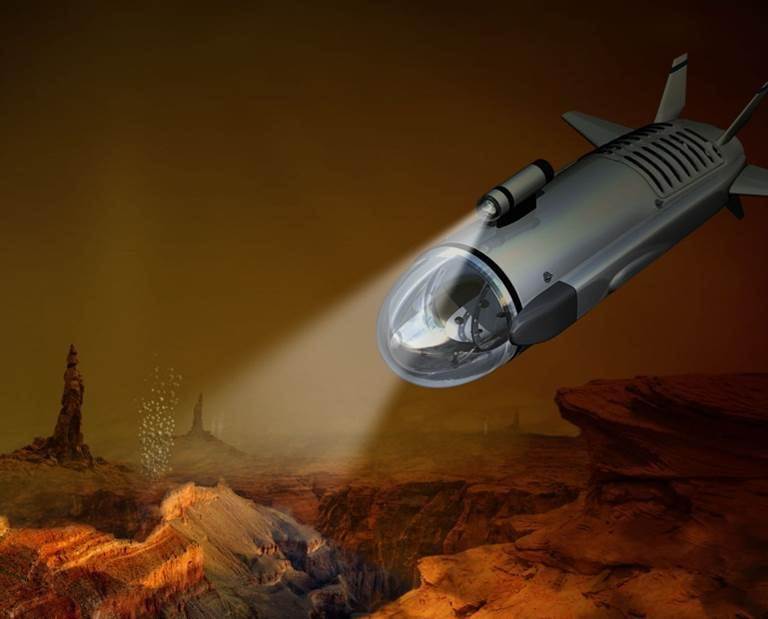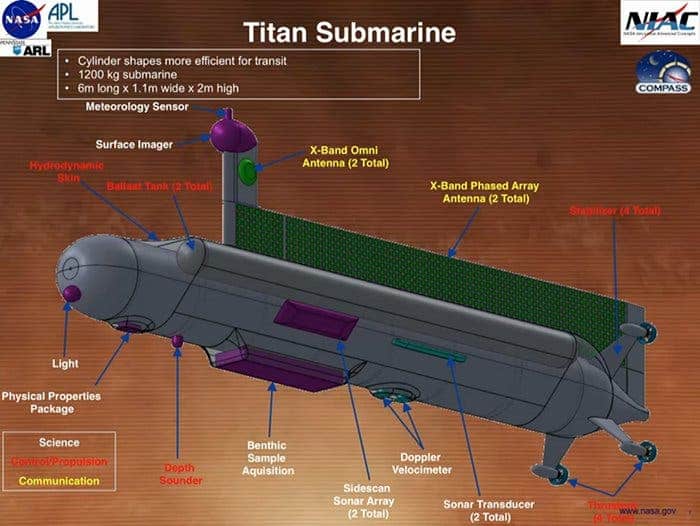NASA plans to explore Saturn’s moon Tian with an unlikely type of vehicle: a submarine. The agency is working on the design of an autonomous submersible that will explore the liquid hydrocarbon oceans of the moon.
The vehicle will have to endure bone-shattering cold as it will peer through the liquid methane and ethane oceans that cover the moon’s surface, relaying valuable data back to Earth, announced Jason Hartwig at the NASA Innovative Advanced Concepts (NIAC) Symposium last week. Its blueprints include a huge communications “fin” on the back of the sub that will allow it to cover the 1,492 million kilometer (886 million miles) span of space to communicate directly with Earth.
The submarine will be 6 meters (20 feet) long and will use Titan’s liquid methane instead of water in its ballast system. Its array of instruments will include meteorological tools, a sonar and radar, and an array of other sensors including cameras to take snapshots of what’s going on on the frigid moon.
The vehicle will be optimized to be as fuel efficient as possible, as chances of re-fueling are slim on Titan.
Ten thousand leagues over the ocean
Titan’s hydrocarbon oceans may be incredibly cold and seem strange to us, but scientists are interested in learning all they can about it as it resembles the conditions we think shaped an early Earth. It’s the only other known body in the Solar System that has stable, liquid seas on its surface. Titan’s atmosphere also functions similarly to our own, having its own hydrological (hydrocarbon?) cycles that dictate how liquids move from fresh to salt or from a gas, to a liquid, or a solid.

Artist rendering of a possible submersible bot exploring one the floor of one of Titan’s methane lakes. Image: NASA JPL
NASA wants to send a sub there because of its versatility. It can be used to measure waves, atmospheric composition and wind speeds on the surface, but can also analyze the composition of its seas or take sea floor samples after it submerges.
“If you can get below the surface of the sea, and get all the way down to the bottom in certain areas, and actually touch the silt that’s at the bottom, and sample it and learn what that’s made of, it’ll tell you so much about the environment that you’re in,” said Michael Paul from Penn State University, one of the researchers working on the project.
The submersible will also look very any signs of extraterrestrial life, as some experts believe the hydrocarbon soup can act as a replacing solvent for water to foster life.
“Think about life on Earth—we’re all either in water or we’re fancy bags of water,” says astrobiologist Kevin Hand of the Jet Propulsion Laboratory. “On Titan, life in the lakes would be ‘bags’ of liquid methane and/or ethane. That 90[Kelvin] liquid would be the solvent and then whatever is dissolved into the lakes would be the material that’s used to build the other components needed for life, and to power metabolism.”
The design efforts for the craft are on hold for now, as the agency awaits for more information on the moon’s oceans from the Cassini probe. New information about the depths, pressures, and temperatures of Titan’s oceans will be used to better tailor the sub to the environment it will function in. NASA hopes to reassess the project by March 2017.
But after the design is finalized and the sub built, that’s when the real waiting begins — its first mission has been tentatively scheduled for 2038.
That’s quite a wait.To help us pass the time, the guys and gals from NASA put together this teaser for the submarine. Enjoy!










